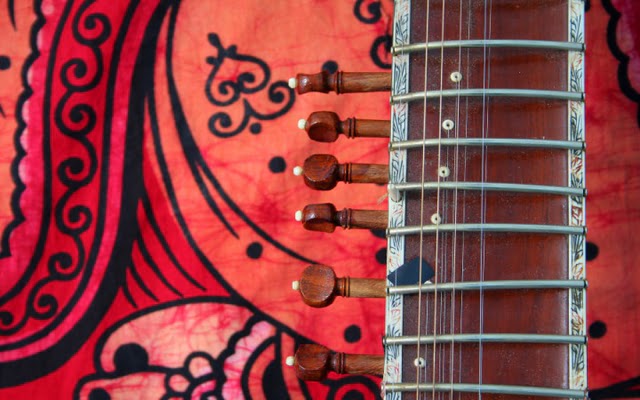
Have you ever dined at an Indian restaurant? Have you ever watched a Bollywood movie? If you’ve ever done either of those things, then chances are you’ve listened to music that featured a unique instrument.
It probably sounded a bit like a guitar but with a distinct reverberating buzz that most people associate with Middle Eastern music. What are we referring to? The sitar, of course!
When you first see a sitar, you might think it resembles a guitar or a banjo. It is approximately four feet long, and most sitars have a body made from a pear-shaped gourd, a long wooden neck, and several tuning pegs and movable frets.
As a stringed instrument, a sitar can have as few as 18 or as many as 21 metal strings. There are typically five or six played strings, one or two drone strings, and up to a dozen sympathetic strings. The drone and sympathetic strings resonate along with the played strings, giving the sitar its distinctive sound.
The sitar is usually played while sitting, with the player holding the instrument at a 45-degree angle on the lap. The right hand is used to pluck the played strings with a metallic pick, known as a mizraab. The left hand is used to create specific notes by applying pressure on or between the frets.
Popular in Hindustani and Indian classical music in countries such as India, Pakistan, and Bangladesh, the sitar likely originated from a Persian lute called the veena. Historians believe its name evolved from another Persian instrument called a sehtar, which meant three (seh) strings (tar).
Most sitars are meticulously handcrafted using various materials. The neck and faceplate are usually made from teak wood or a type of mahogany called tun (pronounced “toon”) wood. Gourds are used for the resonating chambers, and the bridges can be made from ebony, deer horn, or even camel bone.
Although the sitar is an ancient instrument with a rich history, it gained worldwide recognition in the 1950s and 1960s through the work of a musician named Ravi Shankar. In fact, during the 1960s, Shankar taught George Harrison of The Beatles to play the sitar. Harrison played it on several Beatles songs. Brian Jones also played the sitar on The Rolling Stones’ hit “Paint It Black.”
Give It a Try
We hope this Wonder of the Day resonates with you! Invite a friend or family member to join you as you explore the following activities:
Types of Sitars
The sitar is an extraordinary instrument that comes in various types. If you’re interested, you can visit Types of Sitars online to learn about the different varieties of sitars played today.
Sitar Music
Have you ever had the chance to listen to sitar music? If not, you can go online and stream some songs by the renowned sitar musician Ravi Shankar. After listening, try to come up with at least five adjectives that you believe accurately describe the unique sound of the sitar.
Making the Sitar
The creation of a sitar is a complex process. To gain more insight, you can explore Making the Sitar online and read about the various components of the sitar and how they are meticulously crafted. Do you think you have what it takes to build a sitar? Share your thoughts on why or why not, and also mention which part of the process you believe would be the most challenging.





Leave a Reply